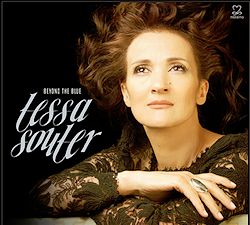Tessa Souter (vocals): Steve Kuhn (piano); David Finck (bass); Joe
Locke (vibes): Joel Frahm (saxophones): Gary Versace (accordion):
Billy Drummond (drums)
Recorded March 2011, Avatar Studios, NYC [60:11]
There are certainly plenty of precedents for appropriating
the classical repertoire for adaptation in other contexts, if one
can put it that way. Better, perhaps, to say that pop singers have
from time to time filched classical melodies, stuck words to them,
and reprised them anew. But Iíve not come across a whole album of
classical melodies to which lyrics have been grafted, and especially
not by a Jazz singer.
Tessa Souter has written most of the lyrics. Mitchell
Parish did the honours for Ravelís Pavane a good long time
ago in the shape of The Lamp is Low, whilst Larry Clinton
adapted Debussyís Reverie and George Forrest and Robert Wright
dealt similarly with the movement from Borodinís Second Quartet. We
all know that best as Baubles, Bangles and Beads.
The rest is Souterís work and the lyrics fit rather
well. Souter has a classy small band to accompany her and arrangements
ensure that colour and variety alike are promoted. On Prelude
to the Sun Ė aka the second movement of Beethovenís Seventh Symphony
Ė Joe Lockeís vibes double Souterís vocal, with more than a hint of
Milt Jackson, whilst the curiously plastic toned tenor sax of Joel
Frahm adds its own, not unattractive gloss. Souter gets sultry with
the Ravel, adds accordion (Gary Versace) for the Borodin Polovetsian
Dances and drapes Albinoniís Adagio, newly christened
Chiaroscuro, in well disguised fashion.
Her lyrics for Rodrigoís evergreen Concerto are
to do with loss and are evocatively romantic, whilst Frahmís tenor
here proves insinuating, the accordion support evocative. Itís certainly
a bold choice to co-opt Brahmsí Third Symphony Ė not sure how I really
take to it Ė but the Chopin Prelude ( Beyond the Blue) is
somewhat more idiomatic, and introspective. Many of these songs are
reflective, slow moving and converted into ballads, so itís refreshing
to come across a swinger or a light-hearted Schubert adaptation (Noaís
Dream is Schubertís Serenade). Souter seems to like
Gabriel Faurť and takes his Pavane as a vehicle, and so too
his Elegy which she calls Brand New Day. The accordion
sits well beneath the vibes, with strangely Spanish hues.
Souter brings a canny sense of warmth, introspection
and, where necessary, agility to bear on these new minted numbers.
Sheís not an especially personalised singer but that allows her to
get beneath the skin of melodies and arrangements and to present them
without idiosyncrasy; other, of course, than the obvious fact that
the whole project is inherently idiosyncratic.
Jonathan Woolf
